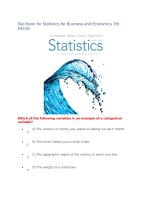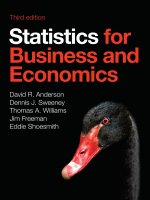Statistics for business economics 7th by paul newbold chapter 13
Bạn đang xem bản rút gọn của tài liệu. Xem và tải ngay bản đầy đủ của tài liệu tại đây (780.29 KB, 45 trang )
Statistics for
Business and Economics
7th Edition
Chapter 13
Additional Topics in
Regression Analysis
Copyright © 2010 Pearson Education, Inc. Publishing as Prentice Hall
Ch. 13-1
Chapter Goals
After completing this chapter, you should be able to:
Explain regression model-building methodology
Apply dummy variables for categorical variables with more than two categories
Explain how dummy variables can be used in experimental design models
Incorporate lagged values of the dependent variable is regressors
Describe specification bias and multicollinearity
Examine residuals for heteroscedasticity and autocorrelation
Copyright © 2010 Pearson Education, Inc. Publishing as Prentice Hall
Ch. 13-2
13.1
The Stages of Model Building
Model Specification
Coefficient Estimation
*
Understand the problem to be
studied
Select dependent and independent
variables
Identify model form (linear,
quadratic…)
Determine required data for the
study
Model Verification
Interpretation and Inference
Copyright © 2010 Pearson Education, Inc. Publishing as Prentice Hall
Ch. 13-3
The Stages of Model Building
(continued)
Model Specification
Coefficient Estimation
Model Verification
Interpretation and Inference
Copyright © 2010 Pearson Education, Inc. Publishing as Prentice Hall
*
Estimate the
regression coefficients
using the available
data
Form confidence
intervals for the
regression coefficients
For prediction, goal is
the smallest se
If estimating individual
slope coefficients,
examine model for
multicollinearity and
specification bias
Ch. 13-4
The Stages of Model Building
(continued)
Model Specification
Coefficient Estimation
Model Verification
Interpretation and Inference
Copyright © 2010 Pearson Education, Inc. Publishing as Prentice Hall
*
Logically evaluate
regression results in
light of the model (i.e.,
are coefficient signs
correct?)
Are any coefficients
biased or illogical?
Evaluate regression
assumptions (i.e., are
residuals random and
independent?)
If any problems are
suspected, return to
model specification
and adjust the model
Ch. 13-5
The Stages of Model Building
(continued)
Model Specification
Coefficient Estimation
Model Verification
Interpretation and Inference
Copyright © 2010 Pearson Education, Inc. Publishing as Prentice Hall
*
Interpret the regression
results in the setting
and units of your study
Form confidence
intervals or test
hypotheses about
regression coefficients
Use the model for
forecasting or
prediction
Ch. 13-6
Dummy Variable Models
(More than 2 Levels)
13.2
Dummy variables can be used in situations in which the categorical variable of interest
has more than two categories
Dummy variables can also be useful in experimental design
Experimental design is used to identify possible causes of variation in the value of the dependent variable
Y outcomes are measured at specific combinations of levels for treatment and blocking variables
The goal is to determine how the different treatments influence the Y outcome
Copyright © 2010 Pearson Education, Inc. Publishing as Prentice Hall
Ch. 13-7
Dummy Variable Models
(More than 2 Levels)
Consider a categorical variable with K levels
The number of dummy variables needed is one less than the number of levels, K – 1
Example:
y = house price ; x1 = square feet
If style of the house is also thought to matter:
Style = ranch, split level, condo
Three levels, so two dummy
variables are needed
Copyright © 2010 Pearson Education, Inc. Publishing as Prentice Hall
Ch. 13-8
Dummy Variable Models
(More than 2 Levels)
(continued)
Example: Let “condo” be the default category, and let x2 and x3 be used for the other
two categories:
y = house price
x1 = square feet
x2 = 1 if ranch, 0 otherwise
x3 = 1 if split level, 0 otherwise
The multiple regression equation is:
yˆ = b0 + b1x1 + b 2 x 2 + b3 x 3
Copyright © 2010 Pearson Education, Inc. Publishing as Prentice Hall
Ch. 13-9
Interpreting the Dummy Variable
Coefficients (with 3 Levels)
Consider the regression equation:
yˆ = 20.43 + 0.045x 1 + 23.53x 2 + 18.84x 3
For a condo: x2 = x3 = 0
yˆ = 20.43 + 0.045x 1
For a ranch: x2 = 1; x3 = 0
yˆ = 20.43 + 0.045x 1 + 23.53
For a split level: x2 = 0; x3 = 1
yˆ = 20.43 + 0.045x 1 + 18.84
Copyright © 2010 Pearson Education, Inc. Publishing as Prentice Hall
With the same square feet, a
ranch will have an estimated
average price of 23.53
thousand dollars more than a
condo
With the same square feet, a
split-level will have an
estimated average price of
18.84 thousand dollars more
than a condo.
Ch. 13-10
Experimental Design
Consider an experiment in which
four treatments will be used, and
the outcome also depends on three environmental factors that
cannot be controlled by the experimenter
Let variable z1 denote the treatment, where z1 = 1, 2, 3, or 4. Let z2 denote the
environment factor (the “blocking variable”), where z2 = 1, 2, or 3
To model the four treatments, three dummy variables are needed
To model the three environmental factors, two dummy variables are needed
Copyright © 2010 Pearson Education, Inc. Publishing as Prentice Hall
Ch. 13-11
Experimental Design
(continued)
Define five dummy variables, x1, x2, x3, x4, and x5
Let treatment level 1 be the default (z1 = 1)
Define x1 = 1 if z1 = 2, x1 = 0 otherwise
Define x2 = 1 if z1 = 3, x2 = 0 otherwise
Define x3 = 1 if z1 = 4, x3 = 0 otherwise
Let environment level 1 be the default (z2 = 1)
Define x4 = 1 if z2 = 2, x4 = 0 otherwise
Define x5 = 1 if z2 = 3, x5 = 0 otherwise
Copyright © 2010 Pearson Education, Inc. Publishing as Prentice Hall
Ch. 13-12
Experimental Design:
Dummy Variable Tables
The dummy variable values can be summarized in a table:
Z1
X1
X2
X3
Z2
X4
X5
1
0
0
0
1
0
0
2
1
0
0
2
1
0
3
0
1
0
3
0
1
4
0
0
1
Copyright © 2010 Pearson Education, Inc. Publishing as Prentice Hall
Ch. 13-13
Experimental Design Model
The experimental design model can be estimated using the equation
The estimated value for β2 , for example, shows the amount by which the y value for
treatment
the value2for2i
treatment
i
03 exceeds
1 1i
3 1 3i
4 4i
5 5i
yˆ = β + β x + β x + β x + β x + β x + ε
Copyright © 2010 Pearson Education, Inc. Publishing as Prentice Hall
Ch. 13-14
13.3
Lagged Values of the
Dependent Variable
In time series models, data is collected over time (weekly, quarterly, etc…)
The value of y in time period t is denoted yt
The value of yt often depends on the value yt-1, as well as other independent variables
xj :
y t = β0 + β1x1t + β 2 x 2t + βK x Kt + γy t −1 + ε t
A lagged value of the dependent
variable is included as an
explanatory variable
Copyright © 2010 Pearson Education, Inc. Publishing as Prentice Hall
Ch. 13-15
Interpreting Results
in Lagged Models
An increase of 1 unit in the independent variable xj in time period t (all other variables
held fixed), will lead to an expected increase in the dependent variable of
βj in period t
βj γ in period (t+1)
βjγ 2 in period (t+2)
βjγ 3 in period (t+3)
and so on
The total expected increase over all current and future time periods is βj/(1-γ )
The coefficients β0, β1, . . . ,βK, γ are estimated by least squares in the usual manner
Copyright © 2010 Pearson Education, Inc. Publishing as Prentice Hall
Ch. 13-16
Interpreting Results
in Lagged Models
(continued)
Confidence intervals and hypothesis tests for the regression coefficients
are computed the same as in ordinary multiple regression
(When the regression equation contains lagged variables, these procedures are only approximately valid.
The approximation quality improves as the number of sample observations increases.)
Copyright © 2010 Pearson Education, Inc. Publishing as Prentice Hall
Ch. 13-17
Interpreting Results
in Lagged Models
(continued)
Caution should be used when using confidence intervals and hypothesis
tests with time series data
There is a possibility that the equation errors εi are no longer independent from one another.
When errors are correlated the coefficient estimates are unbiased, but not efficient. Thus confidence intervals
and hypothesis tests are no longer valid.
Copyright © 2010 Pearson Education, Inc. Publishing as Prentice Hall
Ch. 13-18
13.4
Specification Bias
Suppose an important independent variable z is omitted from a regression model
If z is uncorrelated with all other included independent variables, the influence of z
is left unexplained and is absorbed by the error term, ε
But if there is any correlation between z and any of the included independent
variables, some of the influence of z is captured in the coefficients of the included
variables
Copyright © 2010 Pearson Education, Inc. Publishing as Prentice Hall
Ch. 13-19
Specification Bias
(continued)
If some of the influence of omitted variable z is captured in the coefficients of the
included independent variables, then those coefficients are biased…
…and the usual inferential statements from hypothesis test or confidence intervals can
be seriously misleading
In addition the estimated model error will include the effect of the missing variable(s)
and will be larger
Copyright © 2010 Pearson Education, Inc. Publishing as Prentice Hall
Ch. 13-20
13.5
Multicollinearity
Collinearity: High correlation exists among two or more independent variables
This means the correlated variables contribute redundant information to the multiple
regression model
Copyright © 2010 Pearson Education, Inc. Publishing as Prentice Hall
Ch. 13-21
Multicollinearity
(continued)
Including two highly correlated explanatory variables can adversely affect the regression
results
No new information provided
Can lead to unstable coefficients (large
standard error and low t-values)
Coefficient signs may not match prior
expectations
Copyright © 2010 Pearson Education, Inc. Publishing as Prentice Hall
Ch. 13-22
Some Indications of
Strong Multicollinearity
Incorrect signs on the coefficients
Large change in the value of a previous coefficient when a new variable is added to the
model
A previously significant variable becomes insignificant when a new independent variable
is added
The estimate of the standard deviation of the model increases when a variable is added
to the model
Copyright © 2010 Pearson Education, Inc. Publishing as Prentice Hall
Ch. 13-23
Detecting Multicollinearity
Examine the simple correlation matrix to determine if strong correlation exists between
any of the model independent variables
Multicollinearity may be present if the model appears to explain the dependent variable
well (high F statistic and low se ) but the individual coefficient t statistics are
insignificant
Copyright © 2010 Pearson Education, Inc. Publishing as Prentice Hall
Ch. 13-24
Assumptions of Regression
Normality of Error
Error values (ε) are normally distributed for any given value of X
Homoscedasticity
The probability distribution of the errors has constant variance
Independence of Errors
Error values are statistically independent
Copyright © 2010 Pearson Education, Inc. Publishing as Prentice Hall
Ch. 13-25









